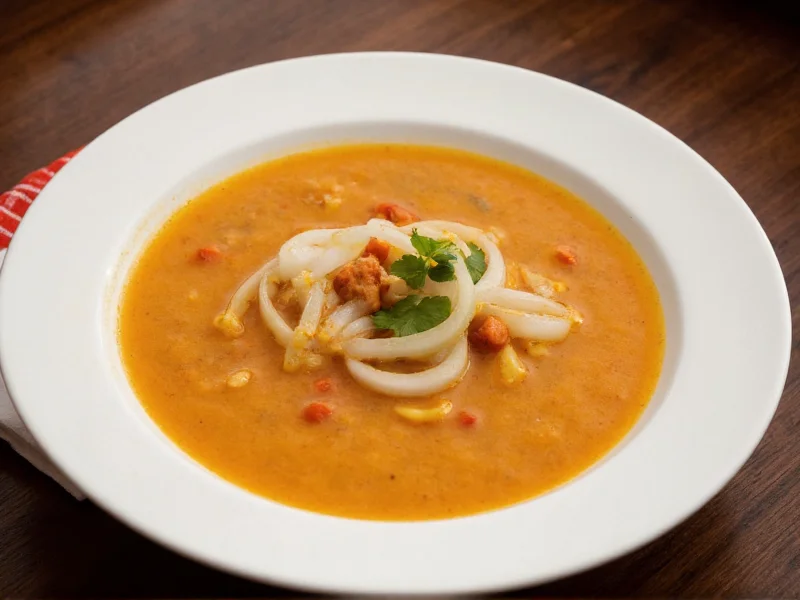The Culinary Science Behind Onion Soup
Onions contain natural sugars and sulfur compounds that undergo the Maillard reaction when cooked slowly. This chemical transformation creates hundreds of new flavor compounds, explaining why properly caramelized onions taste nothing like their raw counterparts. The ideal temperature range for caramelization is 250-325°F (120-160°C) - hot enough to brown but not burn. Adding a pinch of sugar can accelerate the process, though traditional French onion soup relies solely on the onions' natural sugars.
Classic Onion Soup Variations Worldwide
While French onion soup remains the most famous preparation, many cultures feature onion-based soups:
| Soup Type | Key Ingredients | Distinctive Feature |
|---|---|---|
| French Onion Soup | Yellow onions, beef broth, baguette, Gruyère | Baked with cheese-topped croutons |
| German Zwiebel Suppe | Onions, broth, vinegar, caraway | Tangy flavor profile |
| Spanish Sopa de Cebolla | Onions, sherry, bread, Manchego cheese | Includes beaten egg |
| Eastern European Bialy Onpek | Onions, mushrooms, sour cream | Thick, creamy texture |
Mastering Onion Caramelization: Step-by-Step
Perfect caramelized onions separate good onion soup from exceptional. Follow these steps for restaurant-quality results:
- Use 4-5 large yellow onions (about 2 pounds) per standard soup recipe
- Cut onions pole-to-pole for even slices that hold shape
- Melt 2 tablespoons butter with 1 tablespoon olive oil in heavy-bottomed pot
- Add onions with pinch of salt to draw out moisture
- Cook over medium-low heat 10 minutes until softened
- Reduce heat to low and continue cooking 30-40 minutes
- Stir every 5-7 minutes, scraping browned bits from bottom
- Add 1-2 tablespoons water if sticking occurs
- Finish when onions reach deep golden brown color
Authentic French Onion Soup Recipe
This classic preparation delivers rich flavor without complicated techniques:
Ingredients
- 4 large yellow onions, thinly sliced
- 3 tablespoons butter
- 1 tablespoon olive oil
- 6 cups good quality beef broth
- 1 cup dry white wine or sherry (optional)
- 2 cloves garlic, minced
- 1 teaspoon fresh thyme
- Slice of baguette per serving
- 1 cup grated Gruyère cheese
Instructions
- Caramelize onions as described above
- Add garlic and thyme, cook 1 minute until fragrant
- Pour in wine (if using), simmer until mostly evaporated
- Add broth, bring to gentle simmer for 20 minutes
- Preheat broiler, ladle soup into oven-safe bowls
- Top each with toasted baguette slice and cheese
- Broil 2-3 minutes until cheese bubbles and browns
Vegetarian and Dietary Adaptations
Creating delicious onion soup without traditional ingredients requires smart substitutions. For vegetarian onion soup, use mushroom broth or vegetable stock with 1 tablespoon soy sauce to mimic umami depth. Replace wine with apple cider vinegar for acidity. Vegan versions work with nutritional yeast instead of cheese. Those avoiding alcohol can skip the wine step entirely - the soup remains flavorful through proper onion caramelization alone.
Avoiding Common Onion Soup Mistakes
Many home cooks encounter these issues when preparing onion-based soups:
- Bitter onions: Result from cooking too high heat. Maintain low temperature throughout caramelization
- Watery soup: Caused by adding broth too soon. Cook onions until fully caramelized before liquid
- Flat flavor: Missing layering technique. Build flavors with garlic, herbs, and proper seasoning
- Soggy topping: Bread becomes mushy when added too early. Place on soup just before broiling
Serving and Pairing Suggestions
Onion soup shines when paired thoughtfully. Serve French onion soup with a crisp green salad and crusty bread for balanced meal. A dry white wine like Sauvignon Blanc complements the rich broth. For heartier occasions, pair with roast chicken or beef. Consider these perfect pairings for different onion soup variations:
- Classic French onion soup: Arugula salad with lemon vinaigrette
- Creamy onion soup: Crispy bacon or pancetta on the side
- Light vegetable onion soup: Roasted asparagus or green beans
- Spicy onion soup: Cooling cucumber salad
Storage and Reheating Best Practices
Properly stored onion soup maintains quality for future meals. Cool soup completely before transferring to airtight containers. Refrigerate for up to 4 days or freeze for 3 months. When reheating, do so gently over medium-low heat to preserve flavor integrity. Add small amounts of broth if soup has thickened. Never microwave cheese-topped portions - reheat base soup first, then add fresh toppings before serving.











 浙公网安备
33010002000092号
浙公网安备
33010002000092号 浙B2-20120091-4
浙B2-20120091-4